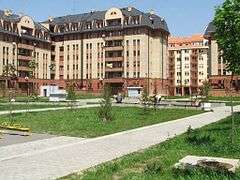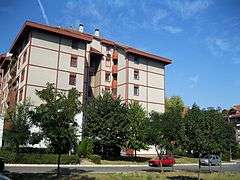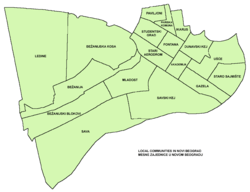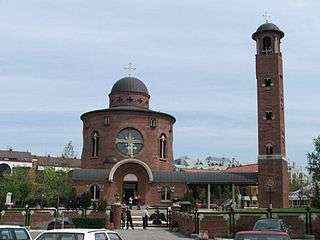Bežanija



Bežanija (Serbian Cyrillic: Бежанија, pronounced [bɛʒǎnija]) is an urban neighborhood of Belgrade, the capital of Serbia. It is located in Belgrade's municipality of Novi Beograd, in the Syrmia region.
Location
Bežanija is located west of the downtown Belgrade, across the Sava river, in the Syrmia region. It is situated in the central part of the Novi Beograd municipality, on the southern extension of the elongated, crescent-shaped yellow loess ridge of Bežanijska kosa. The ridge (or slope, as it is called in Serbian, kosa) gives its name to the northern extension of Bežanija, Bežanijska Kosa, and stretches to the right banks of the Danube in the neighborhood of Zemun. Once a suburb of Belgrade, separated from it by the vast marshlands on the Sava's left bank, Bežanija today forms one completely urbanized area with Belgrade thanks to the rapid development of Novi Beograd after the World War II.
Population
Bežanija experienced a rapid growth of population after 1948 as it was almost immediately attached to the newly constructed city-within-the city of Novi Beograd. It became a local community (Serbian: mesna zajednica) within the Novi Beograd, and as municipal internal boundaries changed a lot in the 1970s, despite further expansion, census showed a reduced number of population as many border areas (entirely or partially) were detached from Bežanija (Bežanijska kosa, blocks 61-65, etc.).
Population of Bežanija (in 1921 and 1953 it was still a separate settlement):
- 1921 - 2,069
- 1953 - 3,330
- 1961 - 7,129
- 1971 - 15,580
- 1981 - 14,067
- 2002 - 13,378
Today, Bežanija extends to the northeast into Bežanijska kosa and the west into Ledine.
History
Bežanija is the oldest part of today's Novi Beograd, where a settlement existed from the neolithic to the Roman period.
In 1512, the settlement of Bežanija was mentioned for the first time under its present name, as a small village with 35 houses, populated by Serbs. In this time, the village was under the administration of the medieval Kingdom of Hungary, and was part of the Syrmia County. The inhabitants of the village crossed the Sava river and settled in Syrmia after fleeing the fall of the medieval Serbian Despotate under the hands of the Ottoman Empire (hence the name bežanija, "refugee camp" in archaic Serbian).
In 1521, the village became part of the Ottoman Empire. From 1527 to 1530, Bežanija was part of Radoslav Čelnik's Duchy of Syrmia, an Ottoman vassal, until its subsequent organization into the Ottoman Sanjak of Syrmia. The Habsburg Monarchy conquered it temporarily during the Great Turkish War (1689-1691), but it remained under Ottoman administration until 1718. In 1718, the village became part of the Habsburg Monarchy and was placed under military administration. It was part of the Habsburg Military Frontier (Petrovaradin regiment of Slavonian Krajina). In 1848-1849 it was part of the Serbian Vojvodina, an ethnic Serb autonomous region within the Austrian Empire, but in 1849 was again placed under administration of the Military Frontier.

As the Frontier was abolished in 1881-1882, it became part of the Syrmia County within the autonomous Habsburg kingdom Croatia-Slavonia, which was located within the Hungarian part of the Dual Monarchy of Austria-Hungary. In 1910, the largest ethnic group in the village were Serbs,[1] while other sizable ethnic groups were Germans, Hungarians and Croats. After dissolution of Austria-Hungary, in autumn of 1918, Bežanija became part of the newly formed State of Slovenes, Croats and Serbs. On November 24, 1918, as part of Syrmia region, the village became part of the Kingdom of Serbia, and on December 1, it became part of the newly formed Kingdom of Serbs, Croats and Slovenes (future Yugoslavia).
From 1918 to 1922, the village was part of the Syrmia County and from 1922 to 1929 part of the Syrmia Oblast. Bežanija became part of the wider Belgrade area for the first time in 1929 after coup d'état conducted by the king Alexander I of Yugoslavia, who, among other things, draw a new map of Yugoslavia's administrative division creating a new administrative unit Uprava grada Beograda or Administration of the City of Belgrade which comprised Belgrade, Zemun (with Bežanija) and Pančevo.
During World War II, from 1941 to 1944, the village was occupied by the Axis Powers and was attached to the Pavelić's Independent State of Croatia. After World War II, Bežanija became part of new socialist Serbia within restored Yugoslavia. It remained part of the Belgrade area but with its own municipality. As the construction of Novi Beograd began in 1948, municipality of Bežanija was abolished an annexed to the municipality of Novi Beograd in 1955 (itself established in 1952), becoming one of its local communities.
Economy
Bežanija is mostly residential area. Some very important industrial facilities are located in the areas geographically, though not administratively, parts of Bežanija: IMT and FOM factories, section of the Belgrade's Waterwoks and Sewage, Minel, etc. Commercial sector is developing recently, including a green market, several gas pumps, a stadium and several shopping malls (like Immo Idea).
West of Bežanija is the location of the old Belgrade airport which was finished in March 1927, destroyed by the Germans in 1944, and became defunct in 1962 when the new airport near the village of Surčin was finished (today's Belgrade Nikola Tesla Airport).
The major transmission grid's substation for western Belgrade is located in Bežanija and was heavily damaged during the NATO bombing of Serbia in 1999. The graphite bombs (or blackout bombs) were used. The major substation for eastern Belgrade, in Leštane was also bombed.
Novo Bežanijsko groblje (New Bežanija cemetery), west of the settlement is Belgrade's largest cemetery. Old cemetery, much smaller, is located in the old part of the settlement.
Sport
Bežanija has many Sports facilities including tennis courts, basketball courts and the Stadion Bežanije, where FK Bežanija play their home matches.
Areas of Bežanija

Bežanijska Kosa

Northeastern extension of the Bežanija, along the loess ridge, is called Bežanijska Kosa (Cyrillic: Бежанијска Коса; slope of Bežanija). It is crescent shaped, leaning on the western border of the urban area of Novi Beograd, stretching along the Tošin bunar street to Zemun. Northern section of the neighborhood is crossed by the Belgrade-Zagreb highway.
It roughly comprises Blocks 6, 35, 49, 50 and 60. Southern section is industrialized (IMT and Minel factories) and the location of the old airport (now a new neighborhood in the process of construction, Airport City Belgrade), while the central parts are mostly residential. Northern section, along the highway, comprises stadiums of the Bežanija and Radnički soccer clubs, auto-camp, hotel Nacional, sports center of 11 April, Bežanija retirement home and one of the major Belgrade hospitals, KBC Bežanijska Kosa. In the northeast it borders the Studentski Grad while northwestern section belongs to the municipality of Zemun. The railway tunnel has been dug through the loess ridge.
It distincts itself from the rest of Novi Beograd as it has no skyscrapers, but smaller, more 'humane' buildings and its population was 19,036 in 2002.
References
- ↑ "Archived copy". Archived from the original on 2011-10-07. Retrieved 2011-06-28.
Further reading
- Mala Prosvetina Enciklopedija, Third edition (1985); Prosveta; ISBN 86-07-00001-2
- Jovan Đ. Marković (1990): Enciklopedijski geografski leksikon Jugoslavije; Svjetlost-Sarajevo; ISBN 86-01-02651-6
Coordinates: 44°48′22.37″N 20°22′19.61″E / 44.8062139°N 20.3721139°E
External links
| Wikimedia Commons has media related to Bežanija. |